Effects of Bi on the microstructure and mechanical property of ZK60 alloy
Zhenghu Hung*,Wnghnbo Liub,Wenjun QiJing XuNn Zhou
aGuangzhou Research Institute of Non-ferrous Metals,Guangzhou 510650,China
bSchool of Materials Science and Engineering,Central South University,Changsha 410083,China
Effects of Bi on the microstructure and mechanical property of ZK60 alloy
Zhenghua Huanga,*,Wanghanbo Liua,b,Wenjun Qia,Jing Xua,Nan Zhoua
aGuangzhou Research Institute of Non-ferrous Metals,Guangzhou 510650,China
bSchool of Materials Science and Engineering,Central South University,Changsha 410083,China
Microstructures and phase compositions of as-cast and extruded ZK60-xBi(x=0-1.64)alloys were investigated.Meanwhile,the tensile mechanical property and hardness were tested.With increasing the Bi content,the as-cast microstructure is frst refned obviously,and then becomes coarse slightly.New small block compound which is rich in Zr,Zn,Bi and poor in Mg increases gradually,and MgZn2phase decreases gradually.The second phase mainly precipitates along the grain boundary.The as-cast tensile mechanical property is frst enhanced obviously, where the tensile strength σb,yield strength σ0.2and elongation δ can reach 265 MPa,151 MPa and 13.5%for ZK60-0.23Bi alloy,respectively, then remains the high value for ZK60-(0.37-1.09)Bi alloys,and fnally decreases obviously for ZK60-1.64Bi alloy.After hot extrusion,the obvious dynamic recrystallization occurs.Broken block compound distributes along the extrusion direction by zonal shape.The average grain size can reach only 4-6 μm.The extruded tensile mechanical property is enhanced signifcantly,where σb,σ0.2and δ are at the range of 345-360 MPa,285-300 MPa and 15.5-19.5%,respectively.Extruded tensile fracture exhibits a typical character of ductile fracture.
ZK60 magnesium alloy;Bi modifcation;Extrusion;Microstructure;Mechanical property
1.Introduction
Magnesium alloy with high specifc strength is used widely in the automotive,communicated,electronic and aerial industries[1].Wrought magnesium alloy exhibits the more excellent comprehensive property including higher strength and better ductility,however the plasticity is still relatively poor owing to the limit of crystal structure(hexagonal close packed,hcp)[2].Therefore,it is necessary to develop the new wrought magnesium alloy with high performance by investigating the deformation mechanism.In order to ameliorate the microstructure and enhance the mechanical property effectively for the widely used ZK60 alloy,rare earth(RE)such as Y[3],Ce[4],Nd[5],Gd[6],Yb[7],Dy[8]and Ho[9]has been added due to its unique atomic electron and chemical property.The average grain size can reach 1 μm,and the tensile strength σb,yield strength σ0.2and elongation δ can reach 395 MPa,355 MPa and 12%respectively when ZK60-4.32Dy alloy was extruded at the extrusion ratio λ and extrusion temperatureTof 40 and 593 K,respectively[8]. However,the commonly expansive price for the rare earth can hinder the wide application into wrought magnesium alloy. Thus,it is necessary to develop the new high performance wrought magnesium alloy without the rare earth.Metal Bi has been added into the Mg-Al series alloys to refne the microstructure and enhance the elevated property effectively through precipitating the Mg3Bi2phase with higher thermal stability[10],but its effects on the microstructure and tensile mechanical property of ZK60 alloy have been rarely studied yet.Therefore,the present paper is focused on studying the microstructures and tensile mechanical properties of as-castand extruded ZK60-xBi(x=0-1.64)alloys in detail,and then discussing the strengthening and deformation mechanisms.
2.Experimental
test at ambient temperature was performed on material test machine(DNS200)at a rate of 2 mm/min.Tensile fractographs were observed using SEM.
3.Results
Chemical compositions of as-cast ZK60-xBi alloys were measured by inductively coupled plasma analyzer(ICP,JY Ultima2).The tested Bi content was 0.23,0.37,0.54,1.09 and 1.64%in weight percent,respectively.Alloy ingots were prepared by melting pure Mg,Zn,Bi and Mg-30%Zr master alloy in an electric resistance furnace under the mixed atmosphere of CO2and SF6.When the melt temperature of pure Mg reached 1003 K,pure Zn,Bi and the master alloy were added into the melt in turn.Then,the melt was stirred twice within 1 h to ensure the compositional homogeneity.After adding the refne agent,the melt was held at 1033 K for 30 min.As the temperature cooled to 988 K,the melt was poured into the wedge permanent mold with a preheated temperature of 523 K,and then as-cast samples were obtained. Casting rods obtained by the same technology were homogenized at 673 K for 8 h in a heat-treating furnace,and then machined to a diameter of 100 mm.Extrusion rods were obtained by an extruder with λ,Tand extrusion speedVof 60, 593 K and 0.5 m/min,respectively.
The as-cast and extruded specimens were etched with 4% HNO3(volume fraction)in ethanol and a solution of 1.5 g picric acid,25 mL ethyl alcohol,5 mL acetic acid plus 10 mL distilled water,respectively.Microstructural observation was carried out on optical microscope(OM,Leica DM IRM), scanning electron microscope(SEM,JEOL JXA-8100)with energy dispersive spectroscopy(EDS,OXFORD 7412).Phase analysis was carried out on X-ray diffractometer(XRD,D/ MAX-RC)with Cu Kαradiation.Vickers hardness test was taken using a load of 9.8 N and a holding time of 20 s.Tensile
3.1.Microstructures and mechanical properties of ascast alloys
Figs.1 and 2 show the optical and SEM graphs of as-cast alloys,respectively.As-cast ZK60 alloy exhibits the coarse microstructure and few dispersed second phase.With increasing the Bi content,the as-cast microstructure is frst refned gradually,where the average grain sizedfrst decreases from about 220 μm for ZK60 alloy to about 40 μm for ZK60-0.54Bi alloy and then becomes coarse slightly when the Bi content exceeds 0.54%.In the meantime,small block compound(see the arrows)increases gradually and mainly precipitates along the grain boundary.A considerable amount nevertheless still distributes within the grains.
Fig.3 shows EDS spectra of as-cast alloys and the results are listed in Table 1.For ZK60 alloy,there exist two different Mg-Zn phases containing relatively low and high Zr contents, respectively.For ZK60-0.23Bi alloy,no new phase containing Bi can be observed distinctly because the added few metal Bi should mainly dissolve into α-Mg matrix.For ZK60-1.09Bi alloy,a new phase containing relatively high Zr,Zn and Bi contents except the Mg-Zn phase can be observed obviously (see the spectrum 1 in Fig.3c),where Zr content can reach 62.06 at.%and while Mg content is only 1.85 at.%.It is different from the precipitated Mg3Bi2phase when metal Bi is added into Mg-Al series alloys.

Fig.1.Optical graphs of as-cast ZK60-xBi alloys.

Fig.2.SEM graphs of as-cast ZK60-xBi alloys.

Fig.3.EDS spectra of as-cast ZK60-xBi alloys.
Fig.4 shows the distribution of each element among as-cast alloys.For ZK60 alloy,majority of element Zn distributes along grain boundary to form Mg-Zn phase and element Zr distributes uniformly.Yet,element Zr gathers obviously for ZK60-1.09Bi alloy and at the same time the gathering region contains high Zn and Bi contents and relatively low Mg content,which is consistent with the EDS results.
In order to determine the block compound owing to the addition of Bi,the comparison between the XRD spectra of ascast ZK60 and ZK60-1.09Bi alloys was made(see Fig.5).It is seen that the XRD spectra of the two alloys consist of the peaks of α-Mg and MgZn2phases,and the peaks of Mg3Bi2phase cannot be observed among the XRD spectrum of ZK60-1.09Bi alloy,which is consistent with the EDS results.
As the Bi content increases,hardness HV increases gradually from 53.8 for as-cast ZK60 alloy to 80.0 for as-cast ZK60-1.64Bi alloy(see Fig.6).Fig.7a shows the tensile mechanical property of as-cast alloys.As-cast ZK60 alloyexhibits the good tensile mechanical property,where σb,σ0.2and δ are 225 MPa,120 MPa and 9%,respectively.When a small amount of Bi(0.23%)is added,σb,σ0.2and δ can be enhanced to 265 MPa,151 MPa and 13.5%,respectively.With increasing the Bi content to 0.37-1.09%,σb,σ0.2and δ change attherangeof250-260 MPa,145-153 MPaand 11.0-14.0%,respectively.When the Bi content furtherly increases to 1.64%,σband δ signifcantly decrease to 190 MPa and 4%,respectively.In the meantime,σ0.2remains almost unchanged.From the SEM morphology of tensile fractures of as-cast alloys shown in Fig.8a-c,it is seen that all as-cast tensile fractures exhibit a complex mode of ductile and brittle fractures.Dimples occupy the majority,while few cleavage steps and river patterns exist for ZK60 alloy.The river patterns increase slightly for ZK60-0.23Bi alloy,whereas decrease slightly again for ZK60-1.09Bi alloy.It is consistent with the change in the elongation.

Table 1EDS results of as-cast ZK60-xBi alloys(atomic percent,at.%).
3.2.Microstructures and mechanical properties of extruded alloys
Because ZK60-0.23Bi and ZK60-1.09Bi alloys exhibit the as-cast fne grain and more excellent tensile mechanical property,the two alloys together with ZK60 base alloy were chosen to study the effects of Bi content on the extruded microstructure and tensile mechanical property.Optical and SEM graphs in the extrusion direction are shown in Figs.9 and 10,respectively.Compared with the as-cast state,the extruded microstructure is refned signifcantly as a result of the dynamic recrystallization(DRX)during the hot deformationprocess.For extruded ZK60 alloy,dynamic recrystallization grains(DRGs)change at a size range from 2 μm to 10 μm withdof 5 μm.Meanwhile,majority of MgZn2phase dissolved through homogenization does not re-precipitate during the hot deformation process.When the relatively small amount of Bi (0.23%)is added,the second phase is still relatively few and the fne recrystallization grains increase slightly.When the added Bi content increases to 1.09%,the broken small block compound enriched in Zr,Zn and Bi tends to distribute along the extrusion direction by zonal shape.Furthermore,the microstructure is not refned further,where the average grain size is equivalent to ZK60 alloy.
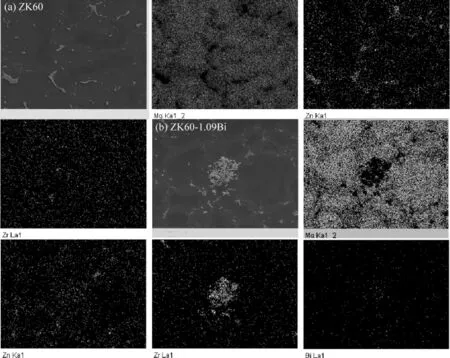
Fig.4.Distribution of each element among as-cast ZK60-xBi alloys.
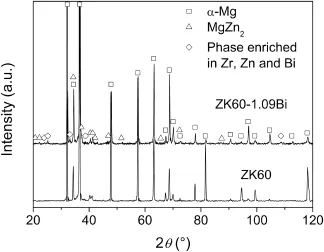
Fig.5.XRD spectra of as-cast ZK60-xBi alloys.
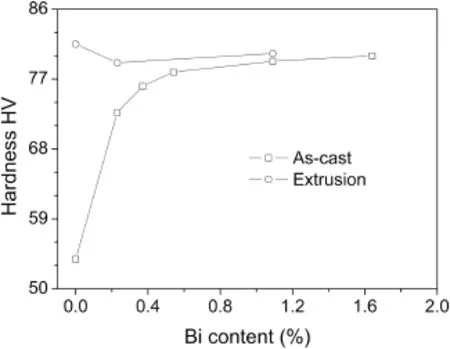
Fig.6.Hardness HV of as-cast and extruded ZK60-xBi alloys.

Fig.7.Tensile mechanical property of as-cast and extruded ZK60-xBi alloys.
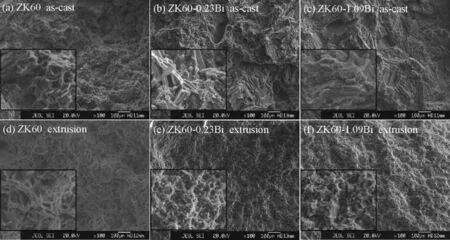
Fig.8.SEM morphology of tensile fractures of as-cast and extruded ZK60-xBi alloys.Illustrations are the local magnifcation.
After hot extrusion,HV value increases to 81.5,79.1 and 80.3forZK60,ZK60-0.23BiandZK60-1.09Bialloys, respectively(see Fig.6).But its increasing amplitude decreases gradually with increasing the Bi content,indicating that the small block compound enriched in Zr,Zn and Bi among the as-cast microstructure is even benefcial to improve the corresponding hardness.

Fig.9.Optical graphs of extruded ZK60-xBi alloys.

Fig.10.SEM graphs of extruded ZK60-xBi alloys.
Compared with the as-cast state,the extruded tensile mechanical property is enhanced signifcantly(see Fig.7b).σb, σ0.2and δ can reach 350 MPa,295 MPa and 19.5%for extruded ZK60 alloy,respectively.σbfrst slightly increases to 360 MPa when a small amount of Bi(0.23%)is added,and then slightly decreases to 345 MPa when the Bi content increases to 1.09%.With increasing the Bi content,δ gradually decrease to 15.5%and σ0.2remains almost unchanged.All extruded tensile fractures change to a typical character of ductile fracture(see Fig.8d-f).For extruded ZK60 alloy, uniform and deep dimples occupy the majority and at the same time few fne second phase particles can be observed at the bottom of dimples.As the Bi content increases,the dimples become shallow and second phase particles increase gradually,which is consistent with the gradual decrease in the elongation.
4.Discussion
During the solidifcation process of the alloys,element Bi is pushed to the solidifcation front,and then the growth of the α-Mg primary crystal is hindered.On the one hand,the higher the Bi content is,the higher the enrichment degree of the solute is,and then the larger the obstacle for the dendrite growth is.On the other hand,new α-Mg nuclei can form in the constitutional supercooling region due to the solute enrichment.Therefore,the as-cast microstructure is refned obviously.However,small block compound enriched in Zr,Zn and Bi segregate signifcantly when the excess Bi content is added. Meanwhile,the useful effect of Zr on refning the microstructure of Mg-Zn series alloys will be weakened.Thus,the as-cast microstructure becomes coarsen slightly when the Bi content exceeds 0.54%.
B水库的单方供水成本从0.17元到0.20元变化,相差值为3分,最高值是最低值的1.2倍,在此基础上确定水价并收取水费,直接影响供水成本弥补额2 619万元,占年成本费用的15%。
As a softening and grain-refning mechanism for magnesium alloy,dynamic recrystallization can ameliorate the deformation microstructure and enhance the mechanical property effectively.Among the infuence factors,thermal vibration and atomic diffusion become stronger,and nucleation rate for dynamic recrystallization increases as the temperature rises.Low deformation speed is favorable for the nucleation and growth of new grain.Improving the deformation degree can increase the nuclei number of new grains.The fner the original microstructure is,the smaller the DRGs are. In addition,second phase particle can hinder the movement of grain boundary undoubtedly[2].
In the present paper,large extrusion ratio(λ=60)can generate large deformation degree and ensure the adequate refnement of the microstructure and the occurrence of dynamic recrystallization. Middle extrusion temperature (T=593 K)can guarantee not only the occurrence of dynamic recrystallization,but also no easy growth of DRGs.Low extrusion speed(V=0.5 m/min)can guarantee the fne microstructure.In addition,the addition of Bi can change the solidus line,reduce solidifcation time and refne the microstructure.Meanwhile,it can change the electronic structure of the alloys,increase the bond energy between atoms and enhance the structural stability.Then the formation and movement of large-angle grain boundary are limited and the growth of DRGs is inhibited[11].Hence,the extruded microstructure is refned signifcantly withdof 4-6 μm.
Strengthening mechanism mainly includes the grainrefnement strengthening,solid-solution strengthening,precipitation strengthening,dispersion strengthening and hardening formagnesium alloy.Among them,thegrainrefnement strengthening is generally considered the most important strengthening mechanism[12,13].In the present paper,when the relatively small amount of Bi(0.23%)is added,the as-cast microstructure is refned signifcantly.Then the tensile mechanical property can be enhanced obviously owing to the grain-refnement strengthening,where σb,σ0.2and δ can reach 265 MPa,151 MPa and 13.5%.When 0.37-1.09%Bi is added,the as-cast microstructure is refned continually or becomes coarsen slightly where the average grain size is still signifcantly smaller than that of the ZK60-0.23Bi alloy.However,the second phases including the MgZn2phase and the small block compound enriched in Zr, Zn and Bi increase gradually,which can lead to the generation of the micro-cracks at the interface under the tension deformation easily.Taking the abovementioned two affects into account,the as-cast tensile mechanical property is not enhanced further for these alloys;however it is still signifcantly better than that for ZK60 alloy.When the Bi content increases to 1.64%,the as-cast microstructure becomes coarsener and the increasing small block compound segregates seriously.Therefore,its as-cast tensile mechanical property deteriorates signifcantly and is even lower than that for ZK60 alloy.
After hot extrusion,the microstructure is refned signifcantly resulting from the dynamic recrystallization,where the average grain size reaches only 4-6 μm.Here,the grainrefnement strengthening plays a prominent effect.Meanwhile,the broken and fne compound enriched in Zr,Zn and Bi can play the dispersion strengthening to a certain extent.Consequently,the extruded tensile mechanical property is enhanced signifcantly.When the small amount of Bi(0.23%) is added,the few second phase and increasing fne recrystallization grains result in a slight enhancement in the tensile strength.When the Bi content increases to 1.09%,the microstructure is not refned further,and then the tensile strength decreases slightly.With increasing the Bi content,the second phase increases gradually and tends to distribute along the extrusion direction by zonal shape,which leads to a slight decrease in the elongation.
5.Conclusions
With increasing the Bi content,the as-cast microstructure is frst refned obviously,and then becomes coarse slightly.New small block compound enriched in Zr,Zn and Bi increases gradually,and MgZn2phase decreases gradually.The as-cast tensile mechanical property is frst enhanced obviously,then remains the high value,and fnally decreases obviously when the Bi content exceeds 1.09%.After hot extrusion,the obvious dynamic recrystallization occurs.Broken block compound distributes along the extrusion direction by zonal shape.The average grain size can reach only 4-6 μm.The extruded tensile mechanical property is enhanced signifcantly,where σb,σ0.2and δ are at the range of 345-360 MPa,285-300 MPa and 15.5-19.5%,respectively.Extruded tensile fracture exhibits a typical character of ductile fracture.
Acknowledgments
TheauthorswouldliketoacknowledgetheMajorScienceand Technology Project of Guangdong Province,China(Grant No. 2010A090200078 and 2011A080403008)for fnancial supports.
[1]I.J.Polmear,Mater.Sci.Technol.10(1994)1-14.
[2]Z.H.Chen,Wrought Magnesium Alloys,Chemical Industry Press,Beijing,2005(in Chinese).
[3]D.K.Xu,L.Liu,Y.B.Xu,E.H.Han,Mater.Sci.Eng.A 443(2007) 248-256.
[4]C.Q.Xia,Y.N.Wang,A.R.Wu,Y.Gu,J.Cent,South Uni.Technol.12 (2005)515-520.
[5]Q.Li,Q.D.Wang,Y.X.Wang,X.Q.Zeng,W.J.Ding,J.Alloys Compd. 427(2007)115-123.
[6]Z.H.Huang,W.J.Qi,J.Xu,Trans.Nonferrous Met.Soc.China 23(2013) 2568-2576.
[7]W.B.Yu,Z.Y.Liu,H.He,N.P.Cheng,X.L.Li,Mater.Sci.Eng.A 478 (2008)101-107.
[8]Z.H.Huang,W.J.Qi,K.H.Zheng,X.M.Zhang,M.Liu,Z.M.Yu,J.Xu, Bull.Mater.Sci.36(2013)437-445.
[9]Z.H.Huang,W.J.Qi,J.Xu,Mater.Sci.Forum 747-748(2013) 359-368.
[10]G.Y.Yuan,Y.S.Sun,W.M.Zhang,J.R.Sun,Trans.Nonferrous Met.Soc. China 10(2000)469-472.
[11]C.J.Ma,M.P.Liu,W.J.Ding,Mater.Sci.Eng.A 349(2003)207-212.
[12]E.O.Hall,Proc.Phys.Soc.B 64(1951)747-753.
[13]N.J.Petch,J.Iron Steel Inst.174(1953)25-28.
Received 28 September 2014;revised 9 December 2014;accepted 18 December 2014 Available online 31 January 2015
*Corresponding author.Tel./fax:+86 20 37238039.
E-mail address:zhhuang@live.cn(Z.Huang).
Peer review under responsibility of National Engineering Research Center for Magnesium Alloys of China,Chongqing University.
http://dx.doi.org/10.1016/j.jma.2014.12.005.
2213-9567/Copyright 2015,National Engineering Research Center for Magnesium Alloys of China,Chongqing University.Production and hosting by Elsevier B.V.All rights reserved.
Copyright 2015,National Engineering Research Center for Magnesium Alloys of China,Chongqing University.Production and hosting by Elsevier B.V.All rights reserved.
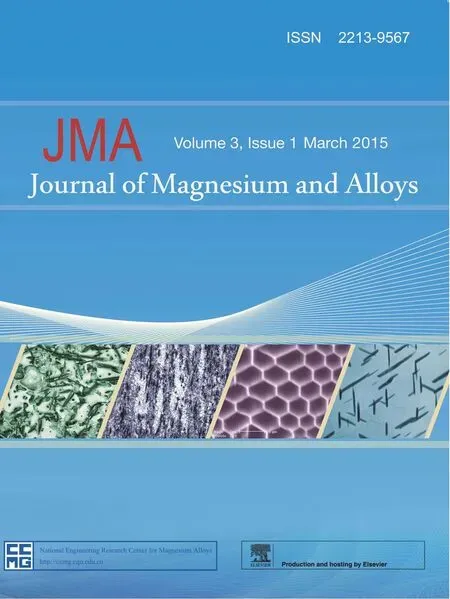 Journal of Magnesium and Alloys2015年1期
Journal of Magnesium and Alloys2015年1期
- Journal of Magnesium and Alloys的其它文章
- GUIDE FOR AUTHORS
- Investigation and corrosion performance of cast Mg-6Al-1Zn+XCa alloy under salt spray test(ASTM-B117)
- Optimization of mechanical and damping properties of Mg-0.6Zr alloy by different extrusion processing
- Synthesize of AZ31/TiC magnesium matrix composites using friction stir processing
- A two-step superplastic forging forming of semi-continuously cast AZ70 magnesium alloy
- Dry sliding wear behavior of an extruded Mg-Dy-Zn alloy with long period stacking ordered phase
